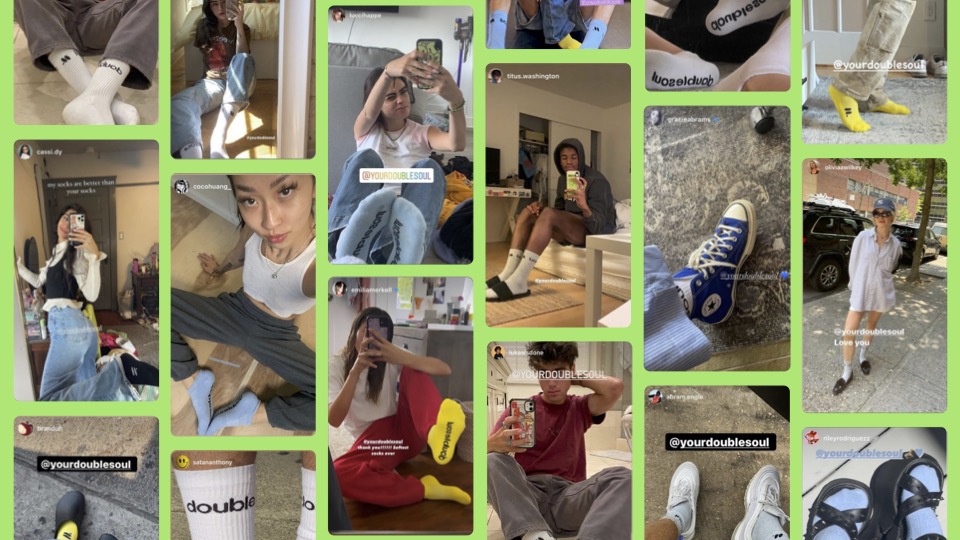‘We don’t care if it’s good or bad’: Brands are updating their user-generated content strategies to stretch marketing dollars

More emerging brands are harnessing the power of user-generated content.
The marketing strategy is nothing new, and marketers often tout it as a more authentic, less polished approach to building brand awareness. However, as more upstart brands tighten up their marketing budgets and seek to lower customer acquisition costs, cheaply-sourced UGC is becoming top-of-mind.
Several founders of early-stage e-commerce companies, all of which launched in the past two years, spoke to Modern Retail about leaning on customer-made content as they battle inflation. The goal is to stretch their marketing dollars by acquiring more customers through UGC content.
Direct-to-consumer sock brand Doublesoul, which launched in June, has relied on user content as its main source of marketing material. Co-Founders Ben Rosenbaum and Allison Strumeyer told Modern Retail that with the brand being specifically geared at Gen Z, less polished customer images tend to be more effective in creating buzz around its gender-neutral socks.
Doublesoul tries to encourage customers, as well as potential ones, to post about the brand in one of a few ways. Earlier this summer, the company encouraged New Yorkers to tag it on Instagram if they saw the brand’s out-of-home ads in exchange for a discount. Doublesoul also asks first-time customers in their email confirmation orders to show how off they wear the socks, then amplifies these photos and videos on the brand’s social media pages.
“We mainly post our customers wearing the socks, and show how each person styles them,” said Strumeyer.
Doublesoul also tries to generate content through gifting creators and social media personalities — such as models, photographers and musicians — and encouraging them to post photos of their socks or Instagram or TikTok.
This initial buzz also helped Doublesoul organically reach celebrity stylists, such as Pete Davidson’s personal stylist — who first came across the socks through friends’ social media posts, the founders said. After introducing the colorful socks to Davidson, Doublesoul posted a photo of the SNL star wearing the socks on its Instagram account, which helped boost traffic to Doublesoul’s website.
Only a few months into Doublesoul’s operations, “so far, we’ve seen over 30% repeat customers, and second basket sizes tend to be double or triple of first order,” Strumeyer. And as the company launches new colors and fabrics, Doublesoul plans to more tap creators and customers to post about their socks.
For DTC brand Oklahoma Smokes, which makes hemp-based, nicotine-free cigarettes to help smokers quit, TikTok users’ content has been the main awareness driver since launching in mid-2020. The company doesn’t do any paid advertising due to restrictions on smoking products. “But even if we could, I wouldn’t want to pay for social ads in today’s environment,” said founder Ashwinn Krishnaswamy.
Since last year, the company has been sending card inserts with every order that ask customers to make a TikTok review. “We don’t care if it’s [review] good or bad, we just ask them to tag us in exchange for a free pack,” he explained. The tactic has been successful in drawing organic content, with 5% of those shoppers posting a review for their followers.
The idea is to generate as much UGC as possible, with hopes of a post going viral every few weeks.
“About eight out of 10 of these videos get a few hundred views, but about 10% to 20% of the time they get a few hundred thousand views that spike our sales,” Krishnaswamy said. One video a customer posted in July had half a million views and drove $14,000 of sales in one day.
Three months ago, the brand also started doing TikTok user giveaways, which Krishnaswamy differentiates from standard influencer gifting. “We search TikTok and reach out to people who talk about quitting smoking or vaping, we introduce ourselves to them and offer to send them products,” Krishnaswamy said. The opt-in rate for this program is about 200 people per month.
“On a CPM basis, this program costs us about 67 cents, which is a bargain considering even TikTok ads’ CPMs are currently at $5,” Krishnaswamy explained.
The biggest drawback to consistently executing UGC campaigns, however, is that it can be tedious and involves a lot of outreach.
Pzaz, a startup that sells a caffeine mist and launched earlier this summer, is also heavily reliant on user-generated content to refresh its TikTok posts daily. Founder Jonah Reider said that TikTok in particular “is primed for UGC, especially when our product and brand is integrated perfectly into a creator’s existing content flow.”
Pzaz sells its products through its own website, as well as at some convenience stores. So far, Pzaz’s team has sourced content from folks who like the product and reach out to the brand, or from customers who already uploaded a video review to our site. Pzaz’s social media pages often prompt followers to visit delis and bodegas and snap photos with the owners while they pick up their Pzaz. The brand’s website features a section of customer reviews that feature selfies and videos of themselves using Pzaz’s spray tubes. “The opportunity cost of creating tons of UGC is low, so we try to keep an evergreen flow of inbound UGC in conjunction with other marketing initiatives,” he explained.
The biggest question for brands hoping to rely more on UGC, however, is predictability, because the conversion outcome can vary depending on virality, Oklahoma Smokes’ Krishnaswamy said. “But from a cost perspective, it’s a pretty effective and passive way to approach UGC,” he said.
For young brands — especially those born out of the pandemic’s volatile advertising environment — user-generated content is an anchor in their digital marketing budgets.
“We want to have organic content sustain us for the coming year as we start testing paid ads,” said Strumeyer.
